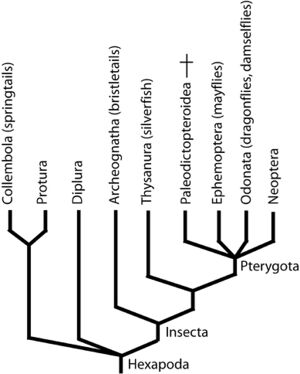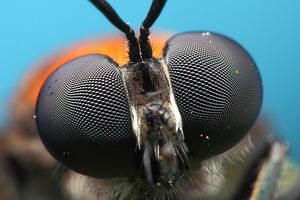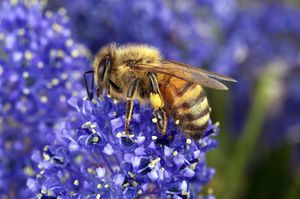Hexapod: Difference between revisions
m The LinkTitles extension automatically added links to existing pages (https://github.com/bovender/LinkTitles). |
|||
| (39 intermediate revisions by 3 users not shown) | |||
| Line 1: | Line 1: | ||
=='''Classification | File:Hexapoda.jpeg | ||
=='''Classification'''== | |||
[[File:Hexapoda.jpeg|thumb|Hexapod Branch]] | |||
'''[[Kingdom]]:''' Animalia | '''[[Kingdom]]:''' Animalia | ||
'''[[Phylum]]:''' Arthropoda | '''[[Phylum]]:''' [[Arthropoda]] | ||
'''[[Subphylum]]:''' Hexapod | '''[[Subphylum]]:''' Hexapod | ||
Hexapods are a subphylum of | Hexapods are a subphylum of arthropoda phylum. Hexapods can be broken down into two groups: insecta and entognatha. Those in the insect group have 3 pairs of legs, a set of wings, and compound eyes. There are more than 1 million species of insects. Those in the entognatha group do not have wings but posess the other features of the insecta group. The entognatha group has mouthparts that can be retracted into their head. | ||
=='''Features of Hexapods | Hexapods are a very diverse subphylum of animalia and consist of many orders that have undiscovered [[organisms]] (more specifically the insecta class). | ||
The Insecta subphylum within the hexapoda Subphylum, is the biggest and most diverse class there is in animalia taxonomy. As of right now, insects represent 80% of the worlds species. | |||
The hexapod subphylum consists of the collembola (springtails), [[protura]] (coneheads), [[diplura]], archaeognatha (bristletails), thysanura ([[silverfish]]), | |||
paleodictopteroidea (extinct beaked insects), ephemoptera (mayflies), odonata (dragonflies and damselflies), and neoptera (winged insects). | |||
=='''Features of Hexapods'''== | |||
[[File:4304690528 b54c7990df b.jpeg|thumb|Compound Eyes]] | [[File:4304690528 b54c7990df b.jpeg|thumb|Compound Eyes]] | ||
Hexapods are composed of three sections: the head, the thorax, and the abdomen. Along with this, hexapods are [[invertebrates]], meaning that | Hexapods are composed of three sections: the head, the thorax, and the abdomen. Along with this, hexapods are [[invertebrates]], meaning that they lack a spine <ref>{{Cite web|url=www.thoughtco.com/hexapods-myriapods-129501.|title=Hexapods Are a Diverse Group of Six-Legged [[Arthropods]]}}</ref>. | ||
On a hexapods head, they have a pair of antennae and compound eyes <ref>{{Cite web|url=https://www.britannica.com/video/216533/Artificial-bug-eyes-could-lead-to-new-vision-systems|title=Hexapods - Hexapoda - Overview - Encyclopedia of Life|website=Encyclopedia of Life|language=en}}</ref>. Compound eyes allow hexapods to use their peripheral vision without having to move their head or body. This helps them escape predators and seek out prey. | |||
On each segment of a hexapod, they have one pair of legs. Some hexapods, such as the dragonfly and the fly, have wings. However, many do not and instead travel using different methods. For example, the [[collembola]] doesn't have wings and travels by its furcula which allows it to jump far distances <ref>{{Cite web|url=www.thoughtco.com/hexapods-myriapods-129501.|title=Hexapods Are a Diverse Group of Six-Legged [[Arthropods]]}}</ref>. | |||
Hexapods, like all insects, have a hard exoskeleton that protects the insect's internal organs. | |||
== '''Habitat''' == | |||
Hexapods are mostly terrestrial species, but a small portion of the species can live in lakes, wetlands, rivers, and marine waters. Hexapods do avoid sub-tidal marine environments because they are unable to survive in shallow seas and the ocean <ref>{{Cite web|url=https://nhpbs.org/wild/Hexapoda.asp.|title=Hexapoda - the [[Insects]]: Wildlife Journal Junior - Wildlife Journal Junior}}</ref>. Since hexapods can live almost anywhere, that helps these animalia to live in abundance all over the world. For every square yard of [[soil]], you can find up to 2,000 different hexapoda species <ref>{{Cite web|url=https://u.osu.edu/eeob3320/2015/04/20/hexapod-part-2/#:~:text=Being%20one%20of%20the%20first,and%20highly%20developed%20sensory%20systems.|title=Hexapod Part 2}}</ref>. | |||
=='''Hexapod Diet'''== | |||
Hexapods are such a vast subphylum that they do not all share a similar diet. Some hexapods are pollinators, parasitoids, predators, or herbivores <ref>{{Cite web|url=https://biosurvey.ou.edu/Invert_manual/Hexapoda.html|title=Phylum Arthropda: Subphylum Hexapoda}}</ref>. Larger hexapods like praying mantises are made to hunt smaller prey, such as beetles and ants, While smaller Hexapods such as leafhoppers are herbivores and eat leaf litter and leaves off of living plants <ref>{{Cite web|url=https://biosurvey.ou.edu/Invert_manual/Hexapoda.html|title=Phylum Arthropda: Subphylum Hexapoda}}</ref>. | |||
== '''Environmental Effects''' == | |||
[[File:Bee.jpg|thumb|Bee Pollinating a Flower]] | |||
Hexapods are | Hexapods do both positive and negative things for the environment. Hexapods are vital for the pollination of flowering plants. Some hexapods, like bees, carry pollen to neighboring flowers. Without them, flowering plants would not be able to germinate. However, Hexapods can also do vast damage to crops as well as spread diseases to other [[animals]] and humans <ref>{{Cite web|url=https://nhpbs.org/wild/Hexapoda.asp.|title=Hexapoda - the [[Insects]]: Wildlife Journal Junior - Wildlife Journal Junior}}</ref>. | ||
== | == '''References''' == | ||
[1] “Hexapoda - the [[Insects]]: Wildlife Journal Junior - Wildlife Journal Junior.” New Hampshire PBS, https://nhpbs.org/wild/Hexapoda.asp. | |||
[2] “Discover How Scientists Have Recreated the Benefits of Insects' Compound Eyes as Compound Lenses.” Encyclopædia Britannica, Encyclopædia Britannica, Inc., https://www.britannica.com/video/216533/Artificial-bug-eyes-could-lead-to-new-vision-systems. | |||
[3] “Phylum Arthropda: Subphylum Hexapoda.” Hexapoda, https://biosurvey.ou.edu/Invert_manual/Hexapoda.html. | |||
2 | [4] Schneider, Courtney. “Hexapod Part 2.” Organismal [[Diversity]], https://u.osu.edu/eeob3320/2015/04/20/hexapod-part-2/#:~:text=Being%20one%20of%20the%20first,and%20highly%20developed%20sensory%20systems. | ||
[5] Strauss, Bob. “Hexapods Are a Diverse Group of Six-Legged [[Arthropods]].” ThoughtCo, ThoughtCo, 10 Jan. 2020, https://www.thoughtco.com/hexapods-myriapods-129501. | |||
Latest revision as of 14:17, 2 May 2025
File:Hexapoda.jpeg
Classification

Kingdom: Animalia
Subphylum: Hexapod
Hexapods are a subphylum of arthropoda phylum. Hexapods can be broken down into two groups: insecta and entognatha. Those in the insect group have 3 pairs of legs, a set of wings, and compound eyes. There are more than 1 million species of insects. Those in the entognatha group do not have wings but posess the other features of the insecta group. The entognatha group has mouthparts that can be retracted into their head.
Hexapods are a very diverse subphylum of animalia and consist of many orders that have undiscovered organisms (more specifically the insecta class).
The Insecta subphylum within the hexapoda Subphylum, is the biggest and most diverse class there is in animalia taxonomy. As of right now, insects represent 80% of the worlds species.
The hexapod subphylum consists of the collembola (springtails), protura (coneheads), diplura, archaeognatha (bristletails), thysanura (silverfish), paleodictopteroidea (extinct beaked insects), ephemoptera (mayflies), odonata (dragonflies and damselflies), and neoptera (winged insects).
Features of Hexapods

Hexapods are composed of three sections: the head, the thorax, and the abdomen. Along with this, hexapods are invertebrates, meaning that they lack a spine [1].
On a hexapods head, they have a pair of antennae and compound eyes [2]. Compound eyes allow hexapods to use their peripheral vision without having to move their head or body. This helps them escape predators and seek out prey.
On each segment of a hexapod, they have one pair of legs. Some hexapods, such as the dragonfly and the fly, have wings. However, many do not and instead travel using different methods. For example, the collembola doesn't have wings and travels by its furcula which allows it to jump far distances [3].
Hexapods, like all insects, have a hard exoskeleton that protects the insect's internal organs.
Habitat
Hexapods are mostly terrestrial species, but a small portion of the species can live in lakes, wetlands, rivers, and marine waters. Hexapods do avoid sub-tidal marine environments because they are unable to survive in shallow seas and the ocean [4]. Since hexapods can live almost anywhere, that helps these animalia to live in abundance all over the world. For every square yard of soil, you can find up to 2,000 different hexapoda species [5].
Hexapod Diet
Hexapods are such a vast subphylum that they do not all share a similar diet. Some hexapods are pollinators, parasitoids, predators, or herbivores [6]. Larger hexapods like praying mantises are made to hunt smaller prey, such as beetles and ants, While smaller Hexapods such as leafhoppers are herbivores and eat leaf litter and leaves off of living plants [7].
Environmental Effects

Hexapods do both positive and negative things for the environment. Hexapods are vital for the pollination of flowering plants. Some hexapods, like bees, carry pollen to neighboring flowers. Without them, flowering plants would not be able to germinate. However, Hexapods can also do vast damage to crops as well as spread diseases to other animals and humans [8].
References
[1] “Hexapoda - the Insects: Wildlife Journal Junior - Wildlife Journal Junior.” New Hampshire PBS, https://nhpbs.org/wild/Hexapoda.asp.
[2] “Discover How Scientists Have Recreated the Benefits of Insects' Compound Eyes as Compound Lenses.” Encyclopædia Britannica, Encyclopædia Britannica, Inc., https://www.britannica.com/video/216533/Artificial-bug-eyes-could-lead-to-new-vision-systems.
[3] “Phylum Arthropda: Subphylum Hexapoda.” Hexapoda, https://biosurvey.ou.edu/Invert_manual/Hexapoda.html.
[4] Schneider, Courtney. “Hexapod Part 2.” Organismal Diversity, https://u.osu.edu/eeob3320/2015/04/20/hexapod-part-2/#:~:text=Being%20one%20of%20the%20first,and%20highly%20developed%20sensory%20systems.
[5] Strauss, Bob. “Hexapods Are a Diverse Group of Six-Legged Arthropods.” ThoughtCo, ThoughtCo, 10 Jan. 2020, https://www.thoughtco.com/hexapods-myriapods-129501.
- ↑ “Discover How Scientists Have Recreated the Benefits of Insects' Compound Eyes as Compound Lenses.” Encyclopædia Britannica, Encyclopædia Britannica, Inc., https://www.britannica.com/video/216533/Artificial-bug-eyes-could-lead-to-new-vision-systems.
- ↑ “Discover How Scientists Have Recreated the Benefits of Insects' Compound Eyes as Compound Lenses.” Encyclopædia Britannica, Encyclopædia Britannica, Inc., https://www.britannica.com/video/216533/Artificial-bug-eyes-could-lead-to-new-vision-systems.
- ↑ “Discover How Scientists Have Recreated the Benefits of Insects' Compound Eyes as Compound Lenses.” Encyclopædia Britannica, Encyclopædia Britannica, Inc., https://www.britannica.com/video/216533/Artificial-bug-eyes-could-lead-to-new-vision-systems.
- ↑ “Discover How Scientists Have Recreated the Benefits of Insects' Compound Eyes as Compound Lenses.” Encyclopædia Britannica, Encyclopædia Britannica, Inc., https://www.britannica.com/video/216533/Artificial-bug-eyes-could-lead-to-new-vision-systems.
- ↑ “Discover How Scientists Have Recreated the Benefits of Insects' Compound Eyes as Compound Lenses.” Encyclopædia Britannica, Encyclopædia Britannica, Inc., https://www.britannica.com/video/216533/Artificial-bug-eyes-could-lead-to-new-vision-systems.
- ↑ “Discover How Scientists Have Recreated the Benefits of Insects' Compound Eyes as Compound Lenses.” Encyclopædia Britannica, Encyclopædia Britannica, Inc., https://www.britannica.com/video/216533/Artificial-bug-eyes-could-lead-to-new-vision-systems.
- ↑ “Discover How Scientists Have Recreated the Benefits of Insects' Compound Eyes as Compound Lenses.” Encyclopædia Britannica, Encyclopædia Britannica, Inc., https://www.britannica.com/video/216533/Artificial-bug-eyes-could-lead-to-new-vision-systems.
- ↑ “Discover How Scientists Have Recreated the Benefits of Insects' Compound Eyes as Compound Lenses.” Encyclopædia Britannica, Encyclopædia Britannica, Inc., https://www.britannica.com/video/216533/Artificial-bug-eyes-could-lead-to-new-vision-systems.